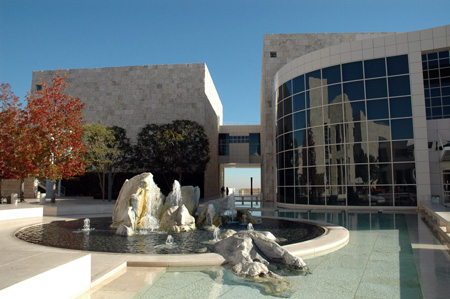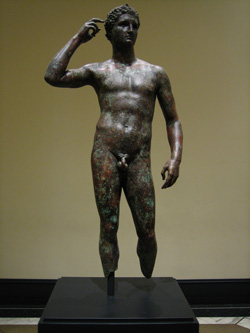The Scoop On Getty's Looted Antiquities

Reporter Jason Felch uncovered improper spending at the Getty Trust. Its
main museum is show here. (Flickr: ngader)
When investigative reporter Jason Felch arrived at the Los Angeles Times in October 2004, the paper's investigative division had just been leaked information on then-president and CEO of the Getty Trust, Barry Munitz.
"I was a new member of the team when the story started," Felch said. "Our arts reporter Louise Roug had been hearing of problems at the Getty and based on that, I was teamed up with Louise and Robin Fields to look into the museum."
What Felch didn't know was that this leak would spiral into a story about collecting stolen antiquities the museum world has known about for decades, and a series of stories that would leave Felch's name forever connected with the world of looted artifacts.
Along with Roug and Fields, Felch began scouting sources and digging through old tax returns. Slowly but surely, internal Getty documents revealed by loyal sources exposed monetary discrepancies or extraordinary expenditures on Munitz's behalf.
"Our first story was about how the Getty had sold land to Eli Broad well below its appraisal value. From there we moved into the broader Munitz story ('The Munitz Collection,' published in June, 2005) and how he had turned the Getty into an instrument [and source of funding for] his wide-ranging non-arts interests."
Felch and his colleagues detailed in the story how Munitz's compensation totaled more than $1 million in 2003.
Felch says getting the scoop on Munitz wasn't easy. "We were worried about vitriol on the hill. A lot of Getty employees hated Munitz for personality reasons so our challenge was to separate out personal animosity from actual rule breaking."
Because of this, Felch and his fellow reporters didn't use anonymous sources in their stories, only confidential ones. They believed anonymous sources would have been more likely to fabricate information just for the sake of getting back at Munitz, but the confidential sources were able to point Felch to information that pinned down Munitz's actions.
"We had confidential sources at every level at the institution all telling us where we should look," Felch said.
Following Munitz's resignation eight months after the stories ran, the Getty story began to change.
"We learned in midst of the Munitz reporting of problems the Getty had with [the Italian government]," Felch said.
Italy had been investigating dealers the Getty had dealt with in the past who had sold stolen antiquities. The Getty was accused of having about 40 such pieces within its collection. To make matters worse, these were private, independent collectors who had sold to the Getty, but whose business was mainly located in Europe.
"I think people didn't realize the scope of what the Italians were up to," Felch said.
Felch's success came from the inside view his Getty ties provided. But help also came in the form of fellow investigative reporter Ralph Frammolino, who joined forces with Felch on the Getty story when antiquities came into the picture.
"Ralph was just ending another project and it was clear I was going to need help with the antiquities side of things. So he [helped me] pick up on that."
Yet ultimately, the duo's reporting was successful because they got both sides of the conversation. Felch said they were able to get inside the museum and report from the inside out.

The Victorious Youth (Flickr: s0crates82).
"The Getty was doing [an] internal review at the time of its own problems," Felch said. "Whatever implications there were, we then, over several trips to Italy and to Greece compared notes with investigators abroad. It was using both [sets of records] that [allowed us to] put together a fuller picture. Foreign authorities had dealer records and we had the Getty."
On one particular trip to Rome, Felch took an additional four-day trip to the seaside town of Fano, Italy, where research had indicated one of the Getty's famous bronze statues (also called the Victorious Youth) originated. Written as a narrative, the story ran in May 2006.
"I knew the Getty Bronze was going to play a key part, and the piece brings up some of the ambiguities [of the Getty case on the whole.] So in Fano, with a Times bureau translator, I tracked down the only surviving member of the crew who explained how the bronze was discovered and smuggled out of Italy."
Though Felch and Frammolino have largely wrapped up their Getty reporting for the Times, they are currently working on a book, "Chasing Aphrodite," that deals with the big picture of antiquities in the museum world today based on their experiences with Italy and the Getty.
"Toward the end of the paper reporting, we realized that the paper is limited by nature," Felch said. "A lot of times there is a time break so what's lost is the broader context; rich details that helps make sense of the facts -- and the color."
Felch compares his Getty reporting to revelations about steroids in baseball, and likens Marion True, the former Getty antiques curator, to one of the most well-known alleged steroid users.
"The Getty Museum had these notions at the time that [buying looted antiquities] would benefit the object and benefit the museum," Felch said. "Yet collecting standards shifted under their feet. And Marion True became the Barry Bonds of the museum world."
Felch said the collecting of looted antiquities was a pervasive practice.
"Marion True is not the first curator to get into deep trouble. So the book came out of realization that the Getty had really changed the museum world and major changes are under way. Just like with steroids and baseball. There was this dirty little secret that everyone knew; that was always denied publicly but on the inside everyone knew what was going on."



